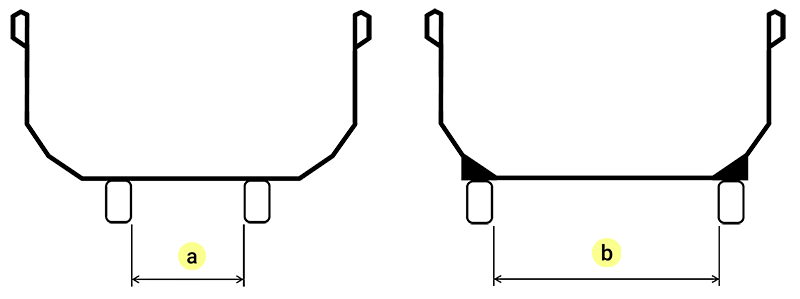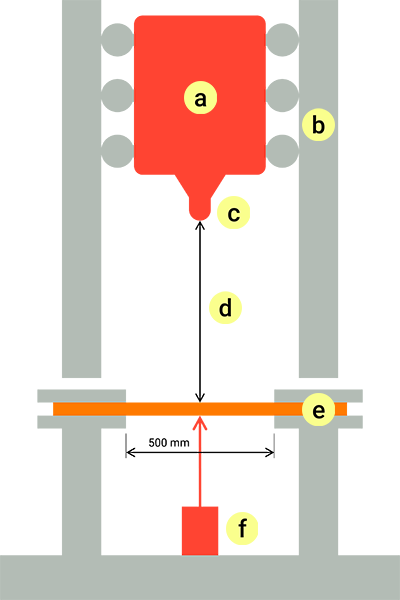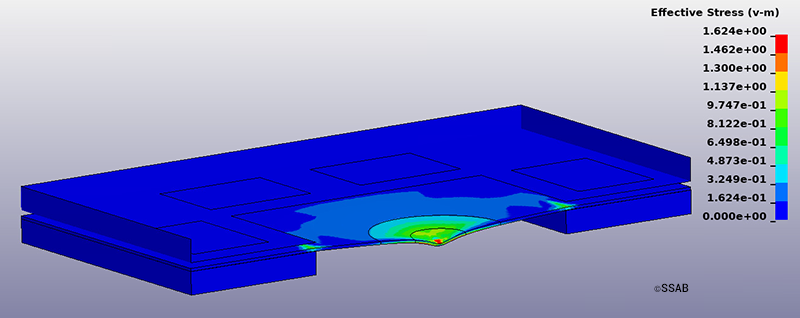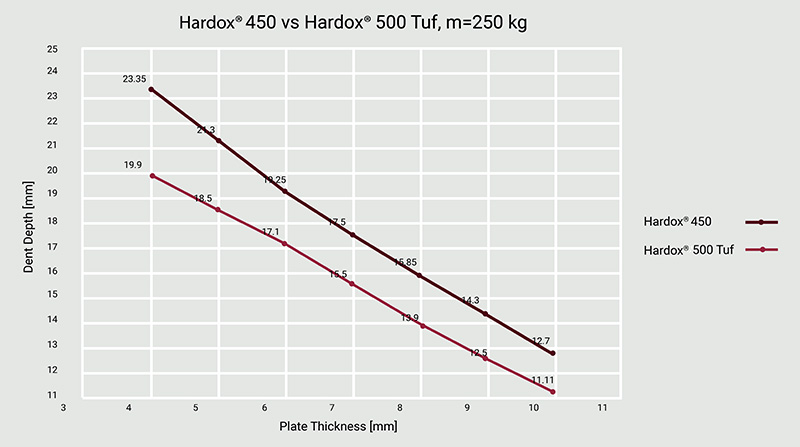Dent resistance parameters
The floor of a heavy-duty or severe-duty truck body, especially if flat, can be prone to dents caused by the impact of heavy or abrasive materials hitting it. Dents are more than just cosmetic imperfections. The defects from dents tend to worsen over time, and if the dents are left unrepaired, they can affect the paint job, the structural integrity, the truck’s resale value, and ultimately the equipment lifetime. So, avoiding time-consuming or costly repairs makes financial sense.
Several key parameters affect denting in a dump truck or tipper. Below, we discuss the type, weight and geometry of the falling object, plate thickness, free length and drop height. A solid understanding of these parameters will help you choose the right steel and design for your dump body.
Rock weight
How should the body be designed if it needs to handle blasted rocks from a primary crusher or secondary crusher? To understand the answer, we need to know something about the rocks’ weight. This is not straightforward because rocks have different complex shapes, and different mineral compositions with varying densities. However, the weight of a rock increases significantly as its diameter increases, as shown in the table below.
The rock size defines the crusher gap: a) Minimum crusher gap. b) Maximum crusher gap.
| Blast rock |
Primary cruscher |
Secondary crucher |
|
| Size | Maximum: 600-1200 mm (24—42”) |
Minimum: 250 mm (10”) Maximum: 500 mm (20”) |
Minimum: 50—100 mm (2—4”) |
| Weight | Maximum: 183–1460 kg (403–3219 lbs.) | Maximum: 140 kg (309 lbs.) | Nominal: 7 kg (15 lbs.) |
Typical stone sizes and weights for blasted and crushed rock.
Typically a dump body is loaded with a mix of rocks, sand, clay and water and contains voids, so the rock density is not directly proportional to the volume of the body. A typical density for crushed aggregate is around 1600 - 1800 kg/m3 (100 – 112 lb/ft3) and the density of granite is 2520 - 2810 kg/m3 (157 - 175 lb/ft3). Because the largest rocks are the ones that cause dents, the rock density is worthwhile considering. Other properties, such as toughness, will also play an important role in dent resistance.
| Rock type |
Density in kg/m3 (lb/ft3) |
| Quartz | 2650 kg/m3 (165 lb/ft3) |
| Magnetite | 5180 kg/m3 (323 lb/ft3) |
| Hematite | 5260 kg/m3 (328 lb/ft3) |
| Feldspar | 2550—2760 kg/m3 (159—172 lb/ft3) |
| Limestone | 1550—2750 kg/m3 (97—172 lb/ft3) |
| Granite | 2520—2810 kg/m3 (157—175 lb/ft3) |
| Concrete | 2000—2400 kg/m3 (125—150 lb/ft3) |
Weight of granite rock of different sizes.
Drop height
When a truck or trailer is loaded, the drop height is mainly determined by the height of the side walls, especially for front loaders. Skilled operators can reduce the risk of dents by avoiding to load large rocks in the first pass to prevent direct hits to the floor.
When loading from an excavator, the operator can load the rocks more gently by lowering them down into the body.
a) Drop height.
Free length
The free length of a truck floor is the distance between longitudinal or transversal beams. This area determines how much elastic energy can be absorbed from a falling rock. There are many ways a dump truck or tipper absorbs energy, for example through rubber pads, use of a U-shaped body and more.

The free width of a truck floor is the distance between the longitudinal beams.
General guidelines for modern tipper bodies
| Rock size | Rock weight |
Possible floor thickness in Hardox® 500 Tuf |
| Blast rock boulders | 700—1,500 kg (1,543—3,307 lbs.) | 8—14 mm (0.315—0.551”) |
| Blast rocks | 300—700 kg (661—1,543 lbs.) | 7—8 mm (0.276—0.315”) |
| Primary crusher larger fraction |
100—300 kg (221—661 lbs.) | 5—7 mm (0.197—0.276”) |
| Primary crusher smaller fraction |
50—100 kg (110—221 lbs.) | 4—5 mm (0.158—0.197”) |
| Secondary crusher |
<50 kg (110 lbs.) | 3—4 mm (0.118—0.158”) |
Typical floor plate thickness in modern half-round tipper body design. Note that this table contains general suggestions for SSAB steel products. This report is subject to SSAB’s Terms of Use. It shall be the user's responsibility to verify that the information contained herein is correct and is suitable to be used for the particular purpose and application of the user.
Tipper body impact tests
To better understand the dent resistance of different steel grades, SSAB built its own test rig. In the rig, different factors could be tested, such as the weight of the object to drop, plate thickness and free area as well as drop height, drop weight and tip radius.

The SSAB drop hammer test rig: a) Applied mass. b) Guide columns. c) Impactor. d) Drop height. e) Specimen between clamps. f) Laser beam.
| Drop height max. | 2.82 m (9.252’) |
| Hammer weight |
180 - 400 kg (397 - 882 lbs.) |
| Impact radius |
30 - 50 mm (1.181 - 1.969”) |
| Frame size opening |
500 x 500 or 800 x 800 mm (20 x 20” or 32 x 32”) |
| Maximum test plate thickness |
50 mm (1.969”) |
Parameters for the impact test rig.
Results from the drop hammer rig show that using Hardox® 500 Tuf instead of Hardox® 450 reduces dent depths. In some cases, even though a thinner plate of Hardox® 500 Tuf is used, it will dent less than Hardox® 450.
Drop hammer impact test for Hardox® 450 and Hardox® 500 Tuf. The dent depths are examples. Other factors, such as suspension and rock toughness, will also influence the dent resistance.
Tipper body impact simulations

Simulation model of the SSAB drop hammer test for a 5 mm steel plate with von Mises effective stress levels in GPa.
The information in this report is only applicable to SSAB’s products and should not be applied to any other products than original SSAB products.
This report provides general results and recommendations for SSAB steel products. This report is subject to SSAB’s Terms of Use. It shall be the user's responsibility to verify that the information contained herein is correct and is suitable to be used for the particular purpose and application of the user. The report is intended to be used by professional users only who possess adequate expertise, qualification and knowledge for the safe and correct use of the results and recommendations in this report. This report is provided “as is”. The use of the report is at user’s own discretion and risk and that users will be solely responsible for any use of this report. SSAB disclaims any liability for the content or potential errors of this report, including but not limited to warranties and condition of merchantability or fitness for a particular purpose or suitability for individual applications. SSAB shall not be liable for any kind of direct or indirect damages and/or costs related to or arising therefrom, whether special, incidental, consequential or directly or indirectly related to the use of, or the inability to use, the report or the content, information or results included therein.


